 W
WThe physical exploration of the Moon began when Luna 2, a space probe launched by the Soviet Union, made an impact on the surface of the Moon on September 14, 1959. Prior to that the only available means of exploration had been observation from Earth. The invention of the optical telescope brought about the first leap in the quality of lunar observations. Galileo Galilei is generally credited as the first person to use a telescope for astronomical purposes; having made his own telescope in 1609, the mountains and craters on the lunar surface were among his first observations using it.
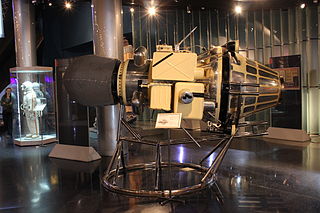 W
WAs part of human exploration of the Moon, numerous space missions have been undertaken to study Earth's natural satellite. Of the Moon landings, Luna 2 of the Soviet Union was the first spacecraft to reach its surface successfully, intentionally impacting the Moon on 13 September 1959. In 1966, Luna 9 became the first spacecraft to achieve a controlled soft landing, while Luna 10 became the first mission to enter orbit.
 W
WThe Apollo program, also known as Project Apollo, was the third United States human spaceflight program carried out by the National Aeronautics and Space Administration (NASA), which succeeded in landing the first humans on the Moon from 1969 to 1972. It was first conceived during Dwight D. Eisenhower's administration as a three-person spacecraft to follow the one-person Project Mercury, which put the first Americans in space. Apollo was later dedicated to President John F. Kennedy's national goal for the 1960s of "landing a man on the Moon and returning him safely to the Earth" in an address to Congress on May 25, 1961. It was the third US human spaceflight program to fly, preceded by the two-person Project Gemini conceived in 1961 to extend spaceflight capability in support of Apollo.
 W
WThe Artemis program is a U.S. government-funded international human spaceflight program that has the goal of landing "the first woman and the next man" on the Moon, specifically at the lunar south pole region, by 2024. The program is carried out predominantly by NASA, U.S. commercial spaceflight companies contracted by NASA, and international partners including the European Space Agency (ESA), the Japan Aerospace Exploration Agency (JAXA), Canadian Space Agency (CSA), the Italian Space Agency (ASI) the Australian Space Agency (ASA), the UK Space Agency (UKSA), the United Arab Emirates Space Agency (UAESA) the State Space Agency of Ukraine, and the Brazilian Space Agency (AEB). NASA is leading the program, but expects international partnerships to play a key role in advancing Artemis as the next step towards the long-term goal of establishing a sustainable presence on the Moon, laying the foundation for private companies to build a lunar economy, and eventually sending humans to Mars.
 W
WThe Artemis Project was a private spaceflight venture to establish a permanent, self-supporting base on the Moon by 2002. It was named after Artemis, the goddess of the hunt, in some myths the moon, and twin sister of Apollo. The project's creators, the Lunar Resources Company, formed the Artemis Society as a non-profit NGO in 1994. They planned to cover the costs by exploiting the entertainment value in creating a lunar colony. They also believed that their costs would be a small fraction of what a government agency, such as NASA, would have spent.
 W
WThe Boeing Human Landing System (HLS) was the name of a proposed lunar lander concept by Boeing that was submitted by Boeing to NASA on 5 November 2019 as part of the Artemis program and the NextSTEP H. The proposal was presented as the "quickest and simplest method" for a 2024 Moon landing. The lunar lander concept was not selected for funding by NASA as part of Artemis in the 30 April 2020 announcement.
 W
WThe Chinese Lunar Exploration Program, also known as the Chang'e Project after the Chinese moon goddess Chang'e, is an ongoing series of robotic Moon missions by the China National Space Administration (CNSA). The program incorporates lunar orbiters, landers, rovers and sample return spacecraft, launched using Long March rockets. Launches and flights are monitored by a telemetry, tracking, and command (TT&C) system, which uses 50-meter (160-foot) radio antennas in Beijing and 40-meter (130-foot) antennas in Kunming, Shanghai, and Ürümqi to form a 3,000-kilometer (1,900-mile) VLBI antenna. A proprietary ground application system is responsible for downlink data reception.
 W
WA circumlunar trajectory, trans-lunar trajectory or lunar free return is a type of free return trajectory which takes a spacecraft from Earth, around the far side of the Moon, and back to Earth using only gravity once the initial trajectory is set.
 W
WColonization of the Moon is a concept employed by some proposals of establishing permanent human settlement or robotic presence on the Moon, the closest astronomical body to Earth.
 W
WCommercial Lunar Payload Services (CLPS) is a NASA program to contract transportation services able to send small robotic landers and rovers to the Moon's south polar region mostly with the goals of scouting for lunar resources, testing in situ resource utilization (ISRU) concepts, and performing lunar science to support the Artemis lunar program. CLPS is intended to buy end-to-end payload services between Earth and the lunar surface using fixed priced contracts.
 W
WThe Constellation Program is a cancelled crewed spaceflight program developed by NASA, the space agency of the United States, from 2005 to 2009. The major goals of the program were "completion of the International Space Station" and a "return to the Moon no later than 2020" with a crewed flight to the planet Mars as the ultimate goal. The program's logo reflected the three stages of the program: the Earth (ISS), the Moon, and finally Mars—while the Mars goal also found expression in the name given to the program's booster rockets: Ares. The technological aims of the program included the regaining of significant astronaut experience beyond low Earth orbit and the development of technologies necessary to enable sustained human presence on other planetary bodies.
 W
WThe Exploration Systems Architecture Study (ESAS) is the official title of a large-scale, system level study released by the National Aeronautics and Space Administration (NASA) in November 2005 in response to American president George W. Bush's announcement on January 14, 2004 of his goal of returning astronauts to the Moon and eventually Mars — known as the Vision for Space Exploration. The Constellation Program was cancelled in 2010 by the Obama Administration and replaced with the Artemis Program in 2017 under the Trump Administration.
 W
WExtraterrestrial real estate refers to claims of land ownership on other planets, natural satellites, or parts of space by certain organizations or individuals. Previous claims are not recognized by any authority, and have no legal standing. Nevertheless, some private individuals and organizations have claimed ownership of celestial bodies, such as the Moon, and are actively involved in "selling" parts of them through certificates of ownership termed "Lunar deeds", "Martian deeds" or similar. While personal claims have little weight, whole countries could potentially lay claim to colonizing certain bodies. Extraterrestrial Real Estate not only deals with the legal standpoints of potential colonization, but how it could be feasible for long-term real estate. There are multiple factors to consider in using another planet for real estate including how to create a real estate market, transportation, planetary protection, astrobiology, sustainability, and the orbital real estate of the planet, as well.
 W
WFallen Astronaut is a 3.5-inch (8.9 cm) aluminum sculpture created by Paul Van Hoeydonck. It is a small stylized figure, meant to depict an astronaut in a spacesuit, intended to commemorate the astronauts and cosmonauts who have died in the advancement of space exploration. It was commissioned and placed on the Moon by the crew of Apollo 15 at Hadley Rille on August 1, 1971, next to a plaque listing the 14 men known who died.
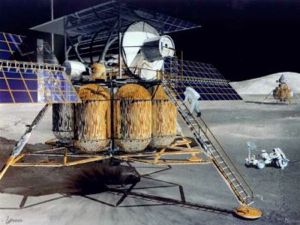 W
WFirst Lunar Outpost was a proposal for a crewed lunar mission that would have launched sometime in the 2010s. It was part of George H. W. Bush's Space Exploration Initiative. The main purpose of the proposal was to offer a much cheaper alternative to NASA's 90-day study from 1989 by a factor of US$30 billion. Although it did not gather much mainstream attention, NASA dedicated much time to assembling a very detailed and thorough proposal. However, the entire Space Exploration Initiative was cancelled soon after the proposal's completion, and NASA had to close the Office of Space Exploration in March of 1993.
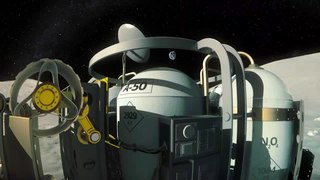 W
WThe Google Lunar XPRIZE (GLXP), sometimes referred to as Moon 2.0, was a 2007–2018 inducement prize space competition organized by the X Prize Foundation, and sponsored by Google. The challenge called for privately funded teams to be the first to land a robotic spacecraft on the Moon, travel 500 meters, and transmit back to Earth high-definition video and images.
 W
WIn space exploration, in situ resource utilization (ISRU) is the practice of collection, processing, storing and use of materials found or manufactured on other astronomical objects that replace materials that would otherwise be brought from Earth.
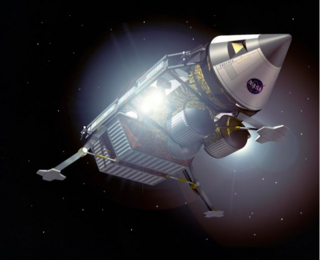 W
WThe International Lunar Resources Exploration Concept (ILREC) was a proposed mission architecture under President George H. W. Bush's Space Exploration Initiative (SEI) by Kent Joosten, an engineer at Johnson Space Center. The plan would have used the help of international partners, mainly the Soviet Union, to assemble a lunar base and sustainable lunar transportation service.
 W
WA Moon landing is the arrival of a spacecraft on the surface of the Moon. This includes both crewed and robotic missions. The first human-made object to touch the Moon was the Soviet Union's Luna 2, on 13 September 1959.
 W
WThis is a list of robotic space probes that have flown by, impacted, orbited or landed on the Moon for the purpose of lunar exploration, as well as probes launched toward the Moon that failed to reach their target.
 W
WA lunar lander or Moon lander is a spacecraft designed to land on the Moon. The Apollo Lunar Module, designed to land a crew of two humans and return them to orbit, made six successful landings and takeoffs from 1969 to 1972.
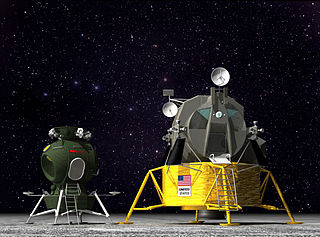 W
WA lunar module is a lunar lander designed to allow astronauts to travel between a spacecraft in lunar orbit and the lunar surface. As of 2020, Apollo Lunar Module was the only lunar module ever used in human spaceflight. Being carried atop a Saturn V launch vehicle, the Apollo LM was used for the Apollo program from 1969 to 1972.
 W
WThe Lunar Orbital Station is a proposed Russian space station in orbit around the Moon. The design was presented in 2007 at a conference at the Gagarin Cosmonaut Training Center in Star City. It is one of the two parts of the planned Russian lunar infrastructure, the other part being a base on the surface of the Moon.
 W
WA lunar outpost is a concept of a permanent or semi-permanent presence of humans on the Moon by the United States space administration NASA. NASA has requested an increase in the 2020 budget of $1.6 billion, in order to make another crewed mission to the Moon by 2024, followed by a sustained presence on the Moon by 2028.
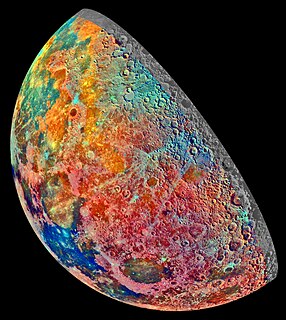 W
WThe Moon bears substantial natural resources which could be exploited in the future. Potential lunar resources may encompass processable materials such as volatiles and minerals, along with geologic structures such as lava tubes that together, might enable lunar habitation. The use of resources on the Moon may provide a means of reducing the cost and risk of lunar exploration and beyond.
 W
WThe Lunar Roving Vehicle (LRV) is a battery-powered four-wheeled rover used on the Moon in the last three missions of the American Apollo program during 1971 and 1972. They are popularly known as "Moon buggies", a play on the words "dune buggy".
 W
WA lunar space elevator or lunar spacelift is a proposed transportation system for moving a mechanical climbing vehicle up and down a ribbon-shaped tethered cable that is set between the surface of the Moon "at the bottom" and a docking port suspended tens of thousands of kilometers above in space at the top.
 W
WMoon is a 2009 science fiction film directed by Duncan Jones and written by Nathan Parker from a story by Jones. The film follows Sam Bell, a man who experiences a personal crisis as he nears the end of a three-year solitary stint mining helium-3 on the far side of the Moon. Kevin Spacey voices Sam's robot companion, GERTY. Moon premiered at the 2009 Sundance Film Festival and was released in selected cinemas in New York and Los Angeles on 12 June 2009. The release was expanded to additional theatres in the United States on 10 July and to the United Kingdom on 17 July. A follow-up film containing an epilogue to the film's events, Mute, was released in 2018. A third installment, Madi: Once Upon A Time in the Future, will be released in 2020.
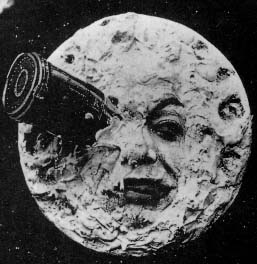 W
WBecause of its extreme difficulty and otherworldly nature, a successful Moon landing is viewed as being among humanity's greatest achievements. A Moon landing combines three essential elements: science, a description of "what" to do that conforms to the physical laws of the universe; technology, a means of "how" to do it using engineering and machines; and finally imagination, the human compulsion of "why" to do it.
 W
WThe Moon Society is a space advocacy organization, founded in 2000, and dedicated to promoting large-scale human exploration, research, and settlement of the Moon.
 W
WA moonbase is a permanent infrastructure sustaining human operations at the Moon.
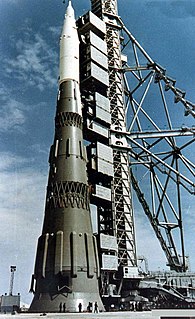 W
WThe N1/L3 was a super heavy-lift launch vehicle intended to deliver payloads beyond low Earth orbit. The N1 was the Soviet counterpart to the US Saturn V and was intended to enable crewed travel to Earth's Moon and beyond, with studies beginning as early as 1959. Its first stage remains the most powerful rocket stage ever built, but all of the four flown N1 Block A first stages failed because of a lack of static test firings that did not reveal plumbing issues and other adverse characteristics with the large cluster of thirty engines and its complex fuel and oxidizer feeder system.
 W
WColonization of the Moon is a concept employed by some proposals of establishing permanent human settlement or robotic presence on the Moon, the closest astronomical body to Earth.
 W
WProject A119, also known as A Study of Lunar Research Flights, was a top-secret plan developed in 1958 by the United States Air Force. The aim of the project was to detonate a nuclear bomb on the Moon, which would help in answering some of the mysteries in planetary astronomy and astrogeology. If the explosive device detonated on the surface, not in a lunar crater, the flash of explosive light would have been faintly visible to people on Earth with their naked eye, a show of force resulting in a possible boosting of domestic morale in the capabilities of the United States, a boost that was needed after the Soviet Union took an early lead in the Space Race and was also working on a similar project.
 W
WThe Space Exploration Initiative was a 1989–1993 space public policy initiative of the George H. W. Bush administration.
 W
WThe Space Exploration Vehicle (SEV) is a modular vehicle concept developed by NASA. It would consist of a pressurized cabin that can be mated either with a wheeled chassis to form a rover for planetary surface exploration or to a flying platform for open space missions such as servicing satellites and missions to near-Earth asteroids. The concept evolved from the Lunar Electric Rover (LER) concept, which in turn was a development of the Small Pressurized Rover (SPR) concept.
 W
WSpaceIL is an Israeli organization, established in 2011, that was competing in the Google Lunar X Prize (GLXP) contest to land a spacecraft on the Moon. SpaceIL successfully launched its Beresheet lander on 22 February 2019 at 01:45 UTC; it entered lunar orbit on 4 April 2019 at 14:18 UTC. On 11 April 2019, during the landing procedure, a problem occurred in the final minutes of flight. Communications were lost with the spacecraft, long enough for the braking process to fail, and the vehicle crashed on the lunar surface. The Beresheet mission had included plans to measure the Moon's magnetic field at the landing site, and was carrying a laser retroreflector, and a "time capsule" containing analog and digital information, created by the Arch Mission Foundation. Beresheet was the first Israeli spacecraft to travel beyond Earth's orbit and was the first privately funded landing on the Moon. Though the spacecraft crashed, Israel became the seventh country to make lunar orbit and the fourth country, after the Soviet Union, the United States, and China to attempt a soft landing on the Moon.
 W
WTranquility Base is the site on the Moon where, in July 1969, humans landed and walked on another celestial body than Earth for the first time. On July 20, 1969, Apollo 11 crewmembers Neil Armstrong and Buzz Aldrin landed their Apollo Lunar Module Eagle at approximately 20:17:40 UTC. Armstrong exited the spacecraft six hours 39 minutes after touchdown, followed 19 minutes later by Aldrin. The astronauts spent two hours 31 minutes examining and photographing the lunar surface, setting up several scientific experiment packages, and collecting 47.5 pounds (21.5 kg) of dirt and rock samples for return to Earth. They lifted off the surface on July 21 at 17:54 UTC.
 W
WA trans-lunar injection (TLI) is a propulsive maneuver used to set a spacecraft on a trajectory that will cause it to arrive at the Moon.
 W
WThe Vision for Space Exploration (VSE) was a plan for space exploration announced on January 14, 2004 by President George W. Bush. It was conceived as a response to the Space Shuttle Columbia disaster, the state of human spaceflight at NASA, and as a way to regain public enthusiasm for space exploration. It was replaced by the space policy of the Barack Obama administration in June 2010.
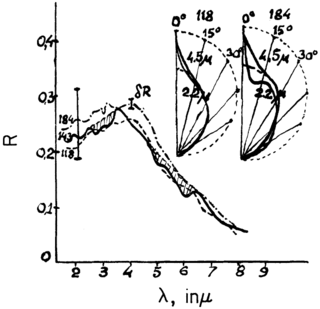 W
WLunar water is water that is present on the Moon. Diffuse water molecules can persist at the Moon's sunlit surface, as discovered by NASA's SOFIA observatory in 2020. Gradually water vapor is decomposed by sunlight, leaving hydrogen and oxygen lost to outer space. Scientists have found water ice in the cold, permanently shadowed craters at the Moon's poles. Water molecules are also in the extremely thin lunar atmosphere.